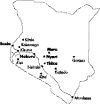Evidence for population level declines in adult HIV prevalence in Kenya
- PMID: 16581755
- PMCID: PMC2593069
- DOI: 10.1136/sti.2005.015990
Evidence for population level declines in adult HIV prevalence in Kenya
Abstract
The HIV/AIDS epidemic in Kenya has been tracked through annual sentinel surveillance in antenatal clinics since 1990. The system started with 13 sites and now has over 35. Behaviours have been measured through national Demographic and Health Surveys in 1993, 1998, and 2003. The surveillance data indicate that prevalence has declined substantially starting in 1998 in five of the original 13 sites and starting in 2000 in another four sites. No decline is evident in the other five original sites although the 2004 estimate is the lowest recorded. Nationally, adult prevalence has declined from 10% in the late 1990s to under 7% today. Surveys indicate that both age at first sex and use of condoms are rising and that the percentage of adults with multiple partners is falling. It is clear that HIV prevalence is now declining in Kenya in a pattern similar to that seen in Uganda but seven or eight years later. Although the coverage of preventive interventions has expanded rapidly since 2000 this expansion was too late to account for the beginnings of the decline in prevalence. More work is needed to understand fully the causes of this decline, but it is encouraging to see Kenya join the small list of countries experiencing significant declines in HIV prevalence.
Conflict of interest statement
Competing interests: none declared
References
-
- National AIDS/STDs Control Programme National HIV Prevalence in Kenya. Nairobi: NASCOP, April, 2004
-
- Stoneburner R, Low‐Beer D. Population‐level HIV declines and behavioral risk avoidance in Uganda. Science 2004304714–718. - PubMed
-
- Joint United Nations Programme on A I D S.Global Epidemic Update 2004. Geneva: UNAIDS, December, 2004
-
- National AIDS/STDs Control Programme National HIV Prevalence in Kenya. Nairobi: NASCOP, March, 2003
Publication types
MeSH terms
LinkOut - more resources
Full Text Sources
Medical




